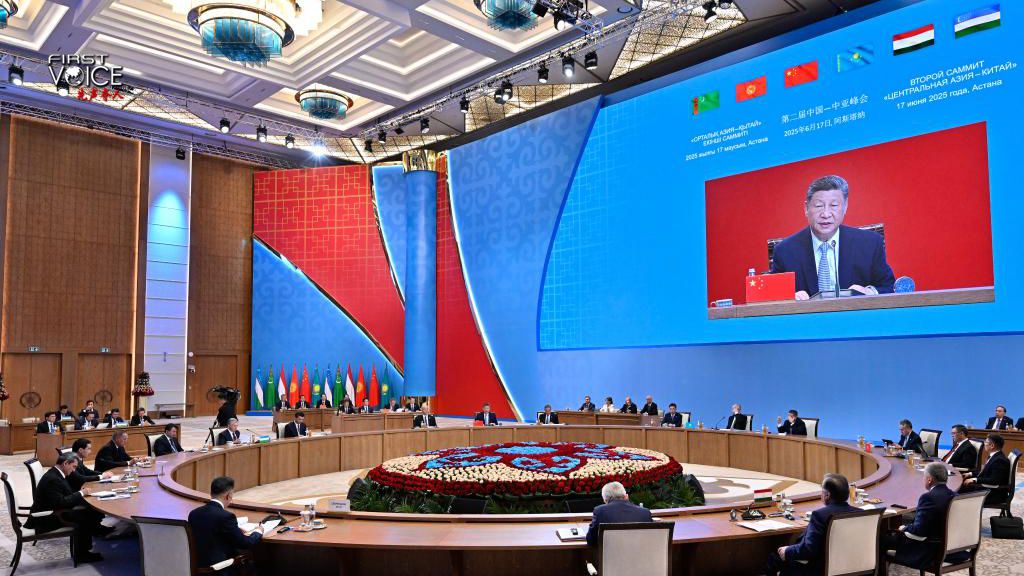
Chinese President Xi Jinping delivers a keynote speech during the second China-Central Asia Summit in Astana, Kazakhstan, June 17, 2025. [Photo/Xinhua]
Editor's note: CGTN's First Voice provides instant commentary on breaking stories. The column clarifies emerging issues and better defines the news agenda, offering a Chinese perspective on the latest global events.
Cooperation is a keyword of this year's China-Central Asia Summit in Astana, Kazakhstan.
"Our cooperation is rooted in more than 2,000 years of friendly exchanges, cemented by solidarity and mutual trust cultivated through more than three decades of diplomatic ties, and taken forward via openness and win-win cooperation of the new era," Chinese President Xi Jinping told the delegates.
The China-Central Asia partnership exemplifies how international relations can be shaped by cooperation rather than competition, by inclusion rather than exclusion, and by shared destiny rather than zero-sum rivalry.
Under the vision of building a community with a shared future, the economic ties between China and Central Asia have witnessed exponential growth in the past decades.
From a modest trade volume of $460 million in 1992, when China first established diplomatic ties with the five Central Asian countries, bilateral trade surged to an unprecedented $94.8 billion by 2024, marking a more than 200-fold increase over three decades. China has emerged as Central Asia's largest trading partner and a major source of investment, with Kazakhstan alone accounting for nearly half of this trade volume at $43.8 billion.
Energy cooperation exemplifies this partnership's depth and strategic importance. Central Asia's abundant reserves of natural gas and minerals have found a reliable and vast market in China. The China-Central Asia gas pipeline, traversing Turkmenistan, Uzbekistan, and Kazakhstan, has delivered over 500 billion cubic meters of natural gas to China since 2009, fueling China's economic growth while generating substantial revenues and infrastructure development in the region.
A key reason for the success and widespread recognition of China-Central Asia cooperation lies in its adherence to principles of mutual benefit, respect for national development priorities, and non-interference.
China tailors its investments and projects to the specific needs of each country, fostering ownership and alignment with local goals. This inclusive approach contrasts with more prescriptive models and has earned trust and appreciation across the region.
The China-proposed Belt and Road Initiative (BRI), for instance, is in alignment with Kazakhstan's Bright Road Initiative, Kyrgyzstan's National Development Program, Tajikistan's National Development Strategy, Turkmenistan's development strategy to revive the Great Silk Road, and Uzbekistan's development plan of "New Uzbekistan," as well as other initiatives of the five Central Asian countries.

The construction site of the second phase of the north-south highway built by China in Kyrgyzstan, October 27, 2020. [Photo/Xinhua]
The BRI projects, numbering over 260 in Central Asia with investments exceeding $136 million, reflect a broad and deep engagement that supports national development and regional integration.
Kazakhstan, with the largest number of Chinese projects, exemplifies how these initiatives contribute to economic diversification and modernization.
The Zhanatas Wind Farm in Kazakhstan, for instance, is one of Central Asia's largest renewable energy projects, generating approximately 350 million kilowatt-hours annually. This project not only addresses local power shortages but also aligns with Kazakhstan's environmental goals, illustrating how China's support is facilitating Central Asia’s energy transition towards sustainability.
Infrastructure connectivity remains a cornerstone of China-Central Asia cooperation. The upcoming China-Kyrgyzstan-Uzbekistan railway, starting from Kashgar in China and passing through mountainous terrain, promises to revolutionize regional trade by reducing travel times and opening new corridors. This project exemplifies the transformation of Central Asia's geography from a barrier into a bridge, reviving its historical role as a vibrant trade hub akin to the ancient Silk Road.
China-Central Asia cooperation stands as a model of mutually beneficial partnership rooted in history, driven by shared development goals, and sustained by respect and trust. The tangible benefits – ranging from massive trade growth and infrastructure development to energy transition and security cooperation – have transformed Central Asia's economic landscape and enhanced the well-being of its peoples.
In this context, the China-Central Asia Summit symbolizes the consolidation of a C5+1 framework that strengthens political trust and outlines a comprehensive strategy for future cooperation.
Amid shifting global power dynamics and regional challenges, China's engagement offers Central Asia a stable, reliable, and development-oriented partner. This cooperation not only enhances economic prosperity but also contributes to regional peace and security, providing a counterbalance to competing influences and fostering a community with a shared future.
In his Tuesday speech, Xi reaffirmed China's commitment to high-quality Belt and Road cooperation, promoting green and digital economies, and deepening people-to-people ties. It will set a new blueprint for collaboration that leverages historical ties, current achievements, and future aspirations to build a prosperous and interconnected Eurasian region.

 中文
中文



